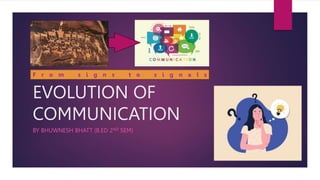
Evolution Of Communication
- 1. EVOLUTION OF COMMUNICATION BY BHUWNESH BHATT (B.ED 2ND SEM) F r o m s i g n s t o s i g n a l s
- 2. What is communication? Exchange of information by speaking, writing, or using some other medium. "Transmission of information"
- 3. Ancient times ( Short Distane ) As we all know we cannot talk without a language. So how did our ancestors communicated? Signs Sounds
- 4. Long Distance The Smoke Signal It is one of the oldest forms of long distance communication. It is a form of visual communication used over long distance. In Ancient China, soldiers stationed along the great wall would alert each other of impending enemy attack by signaling from tower to tower. In this way, they were able to transmit a message as far away as 750km (470miles) in just a few hours.
- 5. Pigeon Post It is the use of homing pigeons to carry messages. Pigeons were effective as messengers due to their natural homing abilities. The Pigeons were transported to a destination in cages, where they would be attached with the messages, and then naturally the pigeon would fly back to its home where the owner could read his mail. Pigeons have been used to great effect in military situations.
- 6. Mailing System Mail or post is a system for transporting letters & other tangible objects: written documents typically enclosed in envelopes & also small packages are delivered to destinations around the world. Anything sent through the postal system is called mail or post. A postal service can be private or public, though many governments place restrictions on private systems.
- 7. Mailing System Relay System receive and pass on Messenger or Rajdoot
- 8. Medieval times The oldest direct handwritten news sheets circulated widely in Venice as early as 1566. These weekly news sheets were full of information on wars and politics in Italy and Europe. The first printed newspapers were published weekly in Germany from 1605. Title page of Carolus' Relation from 1609
- 9. Modern Ways ( The industrial Revolution) The Industrial Revolution (was a period of global transition of human economy towards more efficient and stable manufacturing processes using high tech machines. This occurred during the period from around 1760 from Britain.
- 10. The First thing we got was! After the English government relaxed censorship in 1695, newspapers flourished in London and a few other cities including Boston and Philadelphia. By the 1830s, high-speed presses could print thousands of papers cheaply, allowing low daily costs.
- 11. Telegraph The sender uses symbolic codes, known to the recipient, rather than a physical exchange of an object bearing the message.
- 12. Process of Telegraphy Sender Receiver Decoder
- 13. Telephone In 1876, Alexander Graham Bell was the first to be granted a United States patent for a device that produced clearly intelligible replication of the human voice at a second device.[2] This instrument was further developed by many others, and became rapidly indispensable in business, government, and in households.
- 14. Radio 1894, the young Italian inventor Guglielmo Marconi began working on the idea of building long-distance a wireless transmission systems based on the use of Hertzian waves (radio waves), A regular transatlantic radio-telegraph service was finally begun by him on 17 October 1907.
- 15. Television John Logie Baird is the person who is given credit for inventing the television for the very first time. He experimented in an attic room in London for years until he succeeded in transmitting an old, moving, grayscale image of a talking ventriloquist dummy on a screen in 1925. He called it ‘the Televisor’
- 17. Computing Technology British mathematician Charles Babbage came up with the idea for an automatic computer, powered by steam, in 1837. He finished designing his invention in 1856, more than 100 years before the first electronic ones.
- 19. Internet In 1990, Tim Berners-Lee invented the World Wide Web, or WWW, which is what most people recognize as the Internet today.